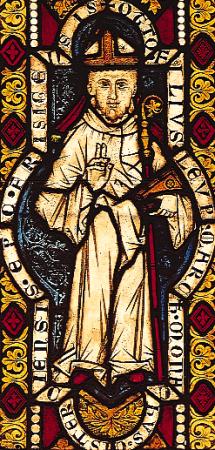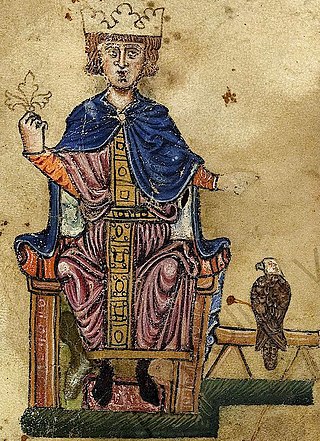Related Research Articles

Frederick Barbarossa, also known as Frederick I, was the Holy Roman Emperor from 1155 until his death 35 years later. He was elected King of Germany in Frankfurt on 4 March 1152 and crowned in Aachen on 9 March 1152. He was crowned King of Italy on 24 April 1155 in Pavia and emperor by Pope Adrian IV on 18 June 1155 in Rome. Two years later, the term sacrum ("holy") first appeared in a document in connection with his empire. He was later formally crowned King of Burgundy, at Arles on 30 June 1178. He was named Barbarossa by the northern Italian cities which he attempted to rule: Barbarossa means "red beard" in Italian; in German, he was known as Kaiser Rotbart, which means "Emperor Redbeard" in English. The prevalence of the Italian nickname, even in later German usage, reflects the centrality of the Italian campaigns to his career.

The Third Crusade (1189–1192) was an attempt led by three European monarchs of Western Christianity to reconquer the Holy Land following the capture of Jerusalem by the Ayyubid sultan Saladin in 1187. For this reason, the Third Crusade is also known as the Kings' Crusade.

Otto of Freising was a German churchman of the Cistercian order and chronicled at least two texts which carries valuable information on the political history of his own time. He was Otto I Bishop of Freising as from 1138. Otto participated in the Second Crusade; he lived through the journey and reached Jerusalem, and later returned to Bavaria in the late 1140s, living for another decade back in Europe.
Frederick VI of Hohenstaufen was duke of Swabia from 1170 until his death at the siege of Acre.

The Göksu is a river on the Taşeli plateau (Turkey). Both its sources arise in the Taurus Mountains—the northern in the Geyik Mountains and the southern in the Haydar Mountains. Their confluence is south of Mut.

Berthold IV, a member of the House of Andechs, was Margrave of Istria and Carniola. By about 1180/82 he assumed the title of Duke of Merania, referring to the Adriatic seacoast of Kvarner which his ancestors had conquered in the 1060s and annexed to Istria and Carniola.

De Arte Venandi cum Avibus, literally On The Art of Hunting with Birds, is a Latin treatise on ornithology and falconry written in the 1240s by the Holy Roman Emperor Frederick II. One of the surviving manuscripts is dedicated to his son Manfred. Manuscripts of De arte venandi cum avibus exist in a two-book version and in a six-book version.
Adelaide of Vohburg was Duchess of Swabia from 1147 and German queen from 1152 until 1153, as the first wife of the Hohenstaufen king Frederick Barbarossa, the later Holy Roman Emperor.
The Battle of Iconium took place on May 18, 1190, during the Third Crusade, in the expedition of Frederick Barbarossa to the Holy Land. As a result, Iconium, the capital city of the Sultanate of Rûm under Kilij Arslan II, fell to the Imperial forces.

The Duchy of Merania was a fiefdom of the Holy Roman Empire from 1152 until 1248. The dukes of Merania were recognised as princes of the Empire enjoying imperial immediacy at a time when these concepts were just coming into use to distinguish the highest ranks of imperial nobility.
The Battle of Philomelion was a victory of the forces of the Holy Roman Empire over the Turkish forces of the Sultanate of Rûm on 7 May 1190 during the Third Crusade.
The History of the Pilgrims is an anonymous Latin account of the expedition of the Emperor Frederick Barbarossa during the Third Crusade (1189–90). It was written not long after events, possibly even before the death of the Emperor Henry VI (1197). It is divided into three sections on the conquests of Saladin, the preparations for the crusade and the crusade itself. The first section contains the most original material and the final section is the longest. It ends abruptly with the death of Barbarossa. The sole surviving manuscript, made in the early 13th century at Salem Abbey, is not quite complete and seems to be missing the last sentences.
Tageno was a Bavarian clergyman and crusader. He was a minor cleric of the cathedral of Passau from at least July 1183. He became dean of the cathedral in 1187 and joined the army of Frederick Barbarossa on the Third Crusade in 1189. He wrote an account in Latin of his experience, known as the Descriptio expeditionis Asiaticae Friderici, covering the period from 1189 down to 21 June 1190. According to the Historia de expeditione Friderici imperatoris, which plagiarized his Descriptio, Tageno died at Tripoli in the autumn of 1190.
Magnus of Reichersberg was an Augustinian canon and historian who worked at Reichersberg Abbey from the 1160s.
The History of the Expedition of the Emperor Frederick is an anonymous Latin account of the campaign waged by Frederick I, Holy Roman Emperor, as part of the Third Crusade. It covers the period 1187–1196, but is centred on the expedition of 1189–1190.

The Deeds of the Emperor Frederick on the Holy Expedition is a short, anonymous Latin account of Frederick Barbarossa's campaign on the Third Crusade (1189–1190). It was probably written in Italy in the 1190s.

Frederick I, nicknamed Barbarossa, was one of the most notable Holy Roman Emperors, who left a considerable political and cultural legacy, especially in Germany and Italy. Thus, he has been the subjects of many studies as well as works of art. Due to his popularity and notoriety, in the 19th and early 20th centuries, he was instrumentalized as a political symbol by many movements and regimes: the Risorgimento, the Wilhelmine government in Germany, and the National Socialist movement. Today, when a tradition-establishing form of commemoration for the emperor is no longer necessary, scholars like Kurt Görich call for neutrality and warn against the instrumentalization of the historical person in the other way. Modern historians generally reject nationalist myths, while portraying the emperor as an influential ruler who suffered many setbacks but often managed to recover. Different studies explore different aspects of his personality, with recent German scholarship emphasizing the emperor's relationship with the chivalrous-courtly culture of the time.
Godfrey of Spitzenberg was a close confidant of Emperor Frederick I and bishop of Regensburg and Würzburg.

De itinere navali is an anonymous Latin account of the siege and capture of Silves in 1189, one of the expeditions of the Third Crusade. It was written by an eyewitness shortly after the events it records. It is known from a single copy made a few decades later. It has been translated into English three times.

The siege of Silves was an action of the Third Crusade and the Portuguese Reconquista in 1189. The city of Silves in the Almohad Caliphate was besieged for from 21 July until 3 September by the forces of Portugal and a group of crusaders from northern Europe on their way to the siege of Acre. The defenders capitulated on terms, the city was handed over to Portugal and the crusaders took a portion of the spoils.
References
- ↑ North, p. 7.
- ↑ This is the translation of North, p. 1. Loud, pp. 8 and 169, gives the alternative translations Letter About the Death of the Emperor Frederick and Letter Concerning the Death of the Emperor Frederick.
- 1 2 John B. Freed (2016), Frederick Barbarossa: The Prince and the Myth, Yale University Press, p. 483.
- 1 2 3 4 5 6 Loud, pp. 8–9.
- 1 2 3 4 5 6 7 North, p. 1.
- ↑ North, p. 7. For the date of the arrival in Tarsus, see Freed, p. 512.
- ↑ Loud, p. 169.